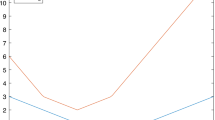Abstract
Interior-point methods have been developed largely for nonlinear programming problems. In this paper, we generalize the global Newton interior-point method introduced in Ref. 1 and we establish a global convergence theory for it, under the same assumptions as those stated in Ref. 1. The generalized algorithm gives the possibility of choosing different descent directions for a merit function so that difficulties due to small steplength for the perturbed Newton direction can be avoided. The particular choice of the perturbation enables us to interpret the generalized method as an inexact Newton method. Also, we suggest a more general criterion for backtracking, which is useful when the perturbed Newton system is not solved exactly. We include numerical experimentation on discrete optimal control problems.
Similar content being viewed by others
References
El-Bakry, A. S., Tapia, R. A., Tsuchiya, T., and Zhang, Y., On the Formulation and Theory of Newton Interior-Point Method for Nonlinear Programming, Journal of Optimization Theory and Applications, Vol. 89, pp. 507–541, 1996.
Kojima, M., Noma, T., and Yoshise, A., Global Convergence in Infeasible-Interior-Point Algorithms, Mathematical Programming, Vol. 65, pp. 43–72, 1994.
Tapia, R. A., and Zhang, Y., Superlinear and Quadratic Convergence of Primal –Dual Interior-Point Methods for Linear Programming Revisited, Journal of Optimization Theory and Applications, Vol. 73, pp. 229–242, 1992.
Eisenstat, S. C., and Walker, H. F., Globally Convergent Inexact Newton Methods, SIAM Journal on Optimization, Vol. 4, pp. 393–422, 1994.
Bellavia, S., Inexact Interior-Point Method, Journal of Optimization Theory and Applications, Vol. 96, pp. 109–121, 1998.
Dennis, J. E., Jr., and Schnabel, R. B., Numerical Methods for Unconstrained Optimization and Nonlinear Equations, Prentice-Hall, Englewood Cliffs, New Jersey, 1983.
Ortega, J. M., and Rheinboldt, W. C., Iterative Solution of Nonlinear Equations in Several Variables, Academic Press, New York, NY, 1970.
Byrd, R. H., and Nocedal, J., A Tool for the Analysis of Quasi-Newton Methods with Application to Unconstrained Minimization, SIAM Journal on Numerical Analysis, Vol. 26, pp. 727–739, 1989.
Dembo, R. S., Eisenstat, S. C., and Sheihaug, T., Inexact Newton Methods, SIAM Journal on Numerical Analysis, Vol. 19, pp. 400–408, 1982.
Anderson, E., et al., LAPACK Users' Guide, SIAM, Philadelphia, Pennsylvania, 1992.
Avriel, M., Nonlinear Programming: Analysis and Methods, Prentice-Hall, New York, NY, 1976.
Fiacco, A. V., and Mccormick, G. P., Nonlinear Programming Sequential Unconstrained Minimization Techniques, SIAM, Philadelphia, Pennsylvania, 1990.
Luenberger, D. G., Linear and Nonlinear Programming, Addison-Wesley, Reading, Massachusetts, 1984.
Wright, M. H., Interior Methods for Constrained Optimization, Acta Numerica, pp. 341–407, 1992.
Wright, S., Primal–Dual Interior-Point Methods, SIAM, Philadelphia, Pennsylvania, 1997.
Author information
Authors and Affiliations
Rights and permissions
About this article
Cite this article
Durazzi, C. On the Newton Interior-Point Method for Nonlinear Programming Problems. Journal of Optimization Theory and Applications 104, 73–90 (2000). https://doi.org/10.1023/A:1004624721836
Issue Date:
DOI: https://doi.org/10.1023/A:1004624721836




